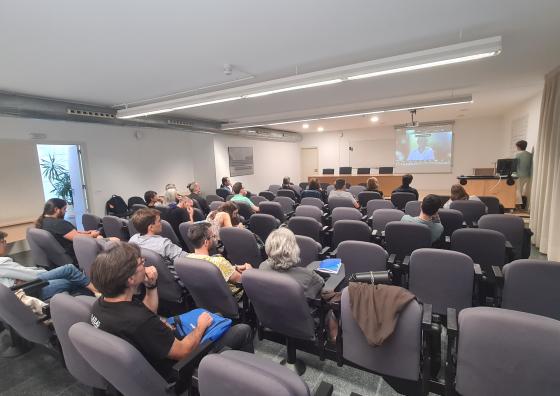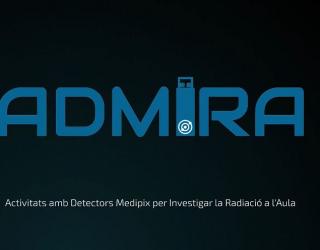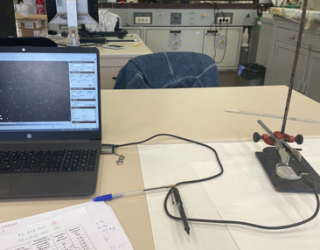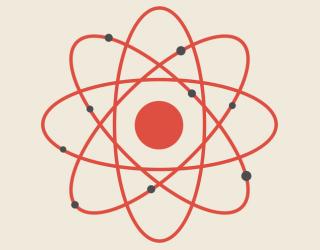On the 13th of September a group of secondary school teachers, students and scientists from the University of Barcelona and CERN gathered for a workshop to inaugurate the academic year 2024-2025 of the ADMIRA initiative. The ADMIRA initiative is an activity with the objective to bring state of the art hybrid pixel detectors developed by the Medipix collaborations to secondary school classes. The key feature of those detectors is that they allow to “visualize” the tracks of particles in the silicon sensor in real time with a simple to use usb-based readout. The visualization of the track allows to identify different types of particles based on the shape of the cluster of pixels fired.
The ADMIRA initiative started in 2019 as a collaboration between CERN, Institut de Ciencies del Cosmos from University of Barcelona (ICCUB) and a group of schools in the region of Catalonia and has been growing in the number of devices that are available to the schools and currently counts with ~31 schools. ~40 schools have participated in the project over the five years and more than a thousand secondary school students from 14 to 18 years old have benefited from the Timepix detector in their classes. The detector allows to visualize different types of natural radiation (from cosmic ray muons to beta radiation generated by the potassium in a banana to the alpha particles generated by radon and its daughter products). The partnership with ICCUB allowed some students to use X-ray tubes at the physics lab at the university while supervised by university staff. Previously to the formal creation of the ADMIRA project, informal work had started in 2016 at a small scale between one of the ASIC designers in the CERN Medipix team and the school where he studied, the Sagrada Familia School in Gava. This allowed students to experiment with the device at the labs and also in individual research works.
ADMIRA is changing the traditional cycle of knowledge in which research centres and Universities create knowledge which is shared with secondary school teachers, who transmit it to their students. ADMIRA is creating bridges between these actors and puts in contact secondary school students with scientists that can supervise their work and give them advice, scientists with teachers in order to create pedagogic content, or secondary school students with universities where they can do some work while supervised and coached by PhD students. The teachers work in network generating novel pedagogic materials and there has even been scientific publications and presentations at international conferences written by secondary school teachers in collaboration with scientists at CERN and at University of Barcelona.
In January 2021 the Medipix team at CERN with the support of the EP department, purchased a number of detectors that have been distributed in schools in Europe. The detectors are based on the Timepix ASIC designed at CERN in the framework of the international Medipix collaborations. They are commercialized by Advacam CZ, that designed a compact USB readout system for operating the detectors. The readout system is named MiniPIX-EDU.
The network created by the members of the ADMIRA initiative and thanks to the initiative by the Medipix team at CERN, has allowed to the creation of clusters of institutes and schools in Spain. The Spanish Teachers Programme at CERN has also been key in establishing contacts between teachers in different regions of the country. Today there are clusters of schools in Barcelona, Madrid, Santiago de Compostela, Pamplona and starting from this year, in Granada. Thanks to the team in Madrid, interested schools from other regions in Spain can have access to the detectors which are sent by the post on a loan for a few days.
Contacts between participants in the different networks take place regularly to share materials and some of these contacts resulted in common research work between people in different clusters. The detector has also been used in measurements that went beyond the subject of physics and that were put in the historical context by the professors.
The new academic course will include as a main novelty a training that will be common to the participants in the different clusters Spain where the participants will learn from world experts about particle detectors and other topics in order to bring the students a bit closer to the state of the art research on particle physics.
ADMIRA, together with other initiatives like the CERN@school started at the UK or the ones led by Czech Technical University in Prague (CZ) can be considered as a precursor for the future TIMEPIX@school project for which the CERN&Society Foundation is raising funds to spread the Timepix hybrid pixel detector technology that started at CERN, across CERN’s member states and beyond.











